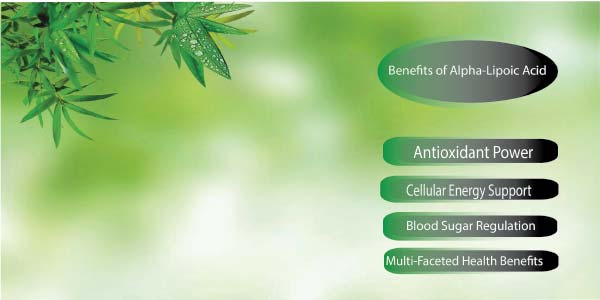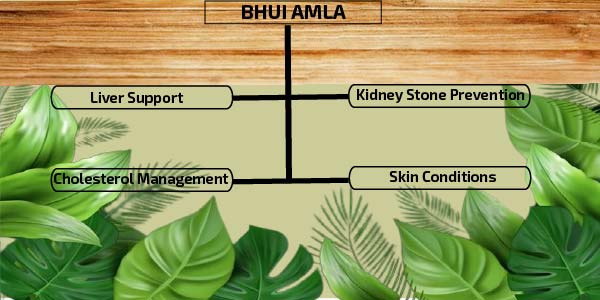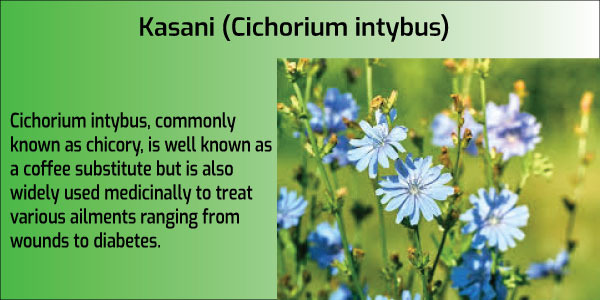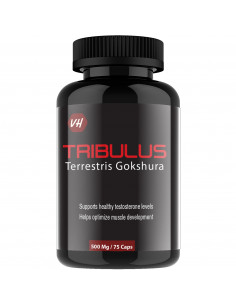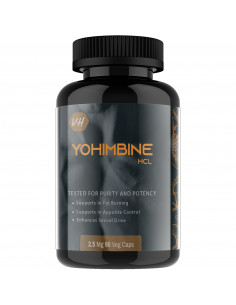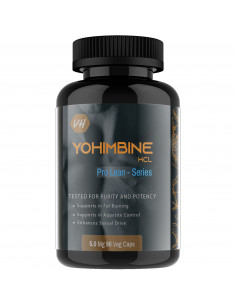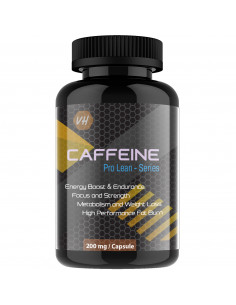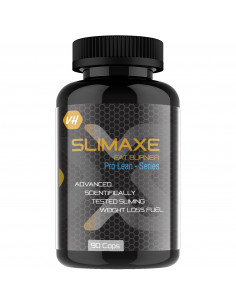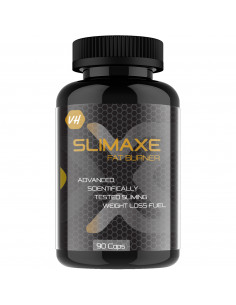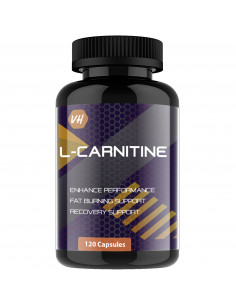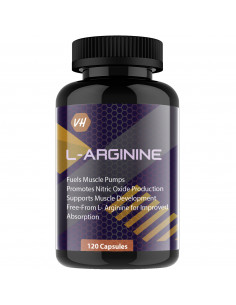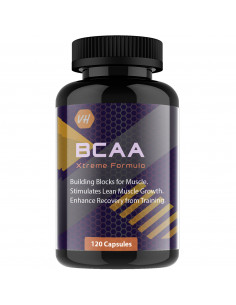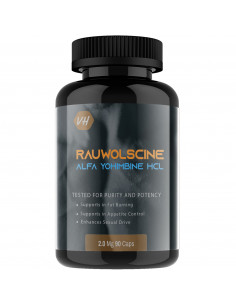- Supplement
- 6 likes
- 5621 views
Yohimbe, and its subset yohimbine hcl and rauwolscine, are fat-burning compounds, primarily used to lose fat during short term fasting.
Vitaminhaat Yohimbine HCl 5mg is a supplement known for supporting weight loss and enhancing wellness. Yohimbine is a Pre workout supplement for burning fat, Also Minimizes the muscle loss.
- Yohimbine is also an aphrodisiac and can aid erectile dysfunction. It is also a general stimulant.
- Yohimbine works by increasing adrenaline levels in the body, as well as inhibiting a regulatory process in fat cells, which normally suppresses fat burning.
- The effects of yohimbine are partially negated by food intake, which is why it is often taken in a fasted state.
Other actions/effects:
Yohimbine exerts a stimulant effect on mood and may increase blood pressure at higher doses. Yohimbine may also have mild antidiuretic action, possibly due to release of antidiuretic hormone.
Bio-Availability :
Rapid ; bioavailability is highly variable, ranging from 7 to 87% (mean 33%); absorption is generally complete within 45 to 60 minutes.
Biotransformation:
Yohimbine appears to undergo extensive metabolism in an organ of high flow such as the liver or kidney; however, the precise metabolic fate of yohimbine has not been fully determined.
Half-life:
Elimination half-life is approximately 36 minutes.
Onset of action:
Approximately 2 to 3 weeks for onset of therapeutic effect.
Elimination:
Renal, less than 1% as unchanged drug.
Recommended dosage, active amounts, other details:
Dosages of 0.2mg/kg body weight have been successfully used to increase fat burning without significant implications on cardiovascular parameters like heart rate and blood pressure. This results in a dosage of:
- 14 mg for a 150lb person
- 18 mg for a 200lb person
- 22 mg for a 250lb person
Supplementation is most effective between meals or during short term fasting. Caution should be exercised at higher body weight, since the cardiovascular system may not be prepared to handle a stimulatory agent such as yohimbine. When supplementing yohimbine for the first time, always start with a half-dose and assess tolerance before proceeding. Caution should also be exercised since many supplements containing yohimbine either do not list how much yohimbine is included, or if they do, the actual dose ranges from 25-150% of the dose listed. Since the dosage may be higher than listed, this is extra reason to start with a lower dose. When pairing yohimbine with other stimulatory agents, half-dose both supplements and work up to the recommended dose cautiously, as two supplements can interact negatively.
Yohimbine, secondary to its alpha-2-adrenergic inhibitory potential, was commonly used as first-line treatment for erectile dysfunction previous to the advent of PDE5 inhibitors. A review that cited the following trials notes a variable efficacy range of 34-73% exists and this may be due to efficacy in persons with psychogenic erectile dysfunction rather than other models of erectile dysfunction, such as organic. Combination therapy of Yohimbine with L-Arginine has shown preliminary benefits with more efficacy in mild to moderate (rather than severe) erectile dysfunction.
Yohimbine acts upon the adrenergic receptor system of fat cells, which regulate thermogenesis. The beta-subunits of the adrenergic receptors (targets of ephedrine) can be seen as stimulatory for fat loss as they increase the activity of the enzyme Adenyl Cyclase and subsequently cAMP levels (mainly via the b1 and b2 subunits; with b3 being less active in humans).
The alpha-subunits are more suppressive of fat metabolism, in which their activation reduces activity of Adenyl Cyclase and reduces cAMP levels (specifically alpha-2). Yohimbine is a selective alpha-2 adrenergic receptor antagonist (inactivator), which inhibits activation of the suppressive set of receptors and preserves Adenyl Cyclase activity and the effects mediated via the beta receptors. Antagonism (Inactivation) of the Alpha-2-Adrenergic receptors preserves fat burning effects mediated via other mechanisms, a negation of a suppressive effect that ultimately results in more lipolysis (fat burning) When looking at the interactions of yohimbine at the receptor level, yohimbine is known as a selective alpha2-adrenergic antagonist as it has 45-fold higher affinity for the alpha2 subunit than it does for the alpha1 subunit; this differs from the related compound corynanthine and rauwolscine which are selective for the alpha1 receptor (33-fold) and essentially non-selective; respectively.
These values were derived from in vitro experimentations, and a second test using competitive binding in brain slices noted that the selectivity was reduced from 45-fold to 5.7. When looking at the alpha2-receptor itself, yohimbine appears to further have selectivity for the alpha2C subunit rather than A or B; in the range of 4-15 times selectivity, while rauwolscine appears to be nonselective among these three subunits. Rauwolscine appears to be as effective on the level of the receptor as yohimbine, with coynanthine being magnitudes less effective. Beyond being an 'Alpha-Adrenergic antagonist', yohimbine has selectivity for the Alpha-2C subunit more than other subunits. Beyond that, yohimbine itself can potentially induce fat loss vicariously through the release of adrenaline; adrenaline itself is an activator of beta-adrenergic receptors. However, this increase of adrenaline may fade with time reaching statistical insignificnace 2 weeks after daily ingestion.
Increases in plasma free fatty acids and the density of alpha2-adrenergic receptors remain similar at both time points, suggesting that yohimbine selectively loses the spike in adrenaline but not direct receptor fat burning effects. May have indirect fat burning mechanisms secondary to adrenaline release from the brain, the positive fat burning effects may be lost after usage despite the 'anti-fat gain' effects of Alpha-2C Antagonism being preserved
Yohimbine was first investigated for its role in selective body fat removal due to its usage as a topical cream (being able to choose where to apply the yohimbine) but also secondary to its usage to eliminate thigh size in women, as elevated estrogen levels increased alpha2-adrenergic receptor activity.
Due to increased amounts of alpha2-adrenergic activity in the thighs of women, antagonism of these receptors was thought to reduce selective adiposity; results with cream are mixed, with one trial coming back positive and the other noted benefit with both forskolin (from Coleus Forskohlii) and aminophylline but not yohimbine. Investigated for the ability to selectively induce fat loss in the thighs of women (which express higher levels of the Alpha2-Adrenergic receptor due to estrogen) but results are mixed and confounded with other compounds.






